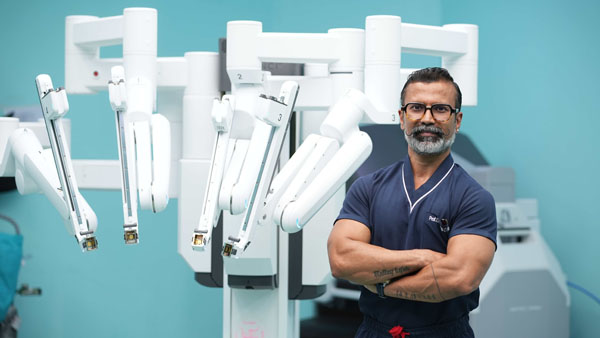
When it comes to surgical options for any disease, usually the first thing that comes to mind is a traditional open approach, where a surgeon operates with handheld instruments through a large cut (incision). Over the last few decades, a less invasive approach called minimal access surgery, which requires a few tiny incisions, has replaced most of the open surgical procedures. These include surgeries with the help of a telescope and long instruments called laparoscopic surgeries, and more recently, the introduction of robotic platforms for robot-assisted surgeries.
Robotic surgery, also known as robot-assisted surgery, combines the precision of robotics with the expertise of human surgeons, leading to improved patient outcomes. Since its introduction about 20 years ago, the use of robots in surgeries has been increasing day by day, and more and more surgeons and hospitals are adopting them. The roots of robotic surgery trace back to the 1980s, when the first robotic system, the PUMA 560, was used to perform neurosurgical biopsies. However, robotic surgeries gained mainstream attention with the introduction of the Da Vinci Surgical System. Developed by Intuitive Surgical, this robotic platform revolutionized minimally invasive surgery by offering enhanced dexterity, precision, and 3D visualization. Almost all of the surgical procedures previously done with laparoscopy can now be performed more precisely with robotic assistance.
Robotic surgery systems consist of a console where the surgeon sits, a robotic arm system equipped with surgical instruments, and a high-definition 3D camera. The surgeon controls the robotic arms using hand and foot controls at the console, translating their movements into precise actions by the robotic system. The advanced technologies allow surgeons to perform intricate procedures with greater control and accuracy.

There are several advantages to robotic-assisted surgery over traditional open or laparoscopic surgery. Robotic surgeries often employ smaller incisions, leading to reduced pain, shorter recovery times, and a lower risk of infection.
Enhanced Precision:
The robotic system helps surgeons with a greater range of motion and improved precision, facilitating meticulous
and delicate dissection.
3D Visualization:
All of the above advantages can be attributed to magnified 3-dimensional vision and a 360-rotation movement of the robotic arms, which allows meticulous dissection of tissues and control of loss of blood. The robotic arms can reach difficult places inaccessible to the surgeon's hands, and their movements are free from the normal tremors. Robotic surgery gives the surgeon a clear and precise view of the anatomy, which results in fewer complications and a quicker recovery. The high-definition 3D camera offers a detailed and magnified view of the surgical site, enabling better decision-making during the procedure.
Quicker Recovery:
Patients undergoing robotic surgeries are likely to experience shorter hospital stays and faster recovery compared to traditional open surgeries. Robotic surgeries are especially superior to conventional and laparoscopic surgeries while operating on pelvic organs like the rectum, uterus, prostrate, kidneys, and other urological procedures, as well as complex abdominal hernias. The future may see further miniaturization of robotic components, increased autonomy, and expanded applications across different medical specialties. As technology continues to evolve, the integration of robotics into the surgical domain holds immense promise for improving patient outcomes and advancing the field of medicine. The journey of robotic surgery has just begun, and the future holds exciting possibilities for this groundbreaking technology. In simpler terms, robotic surgery is like having a highly skilled, super-precise assistant working alongside your surgeon, making surgeries less invasive and potentially leading to quicker recoveries. It's a blend of human expertise and cutting-edge technology, all aimed at making medical procedures safer and more effective for patients like you!